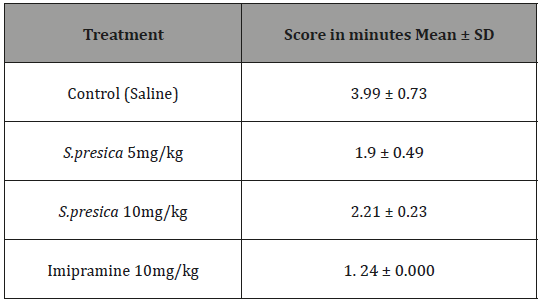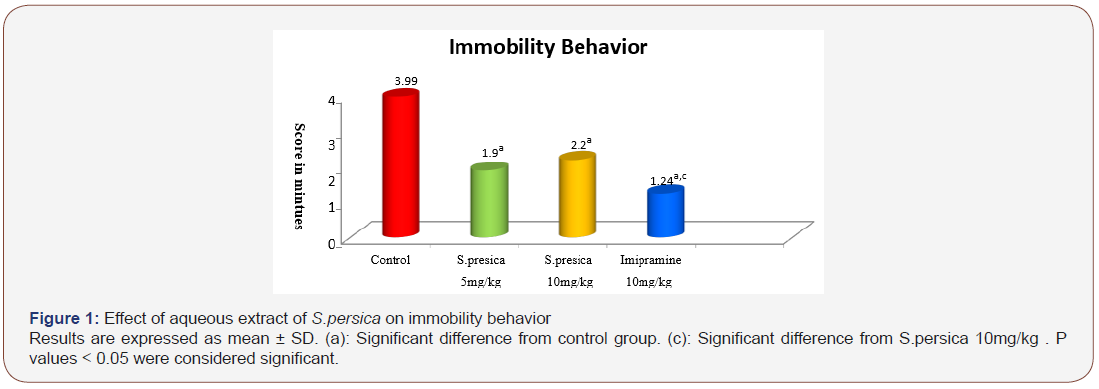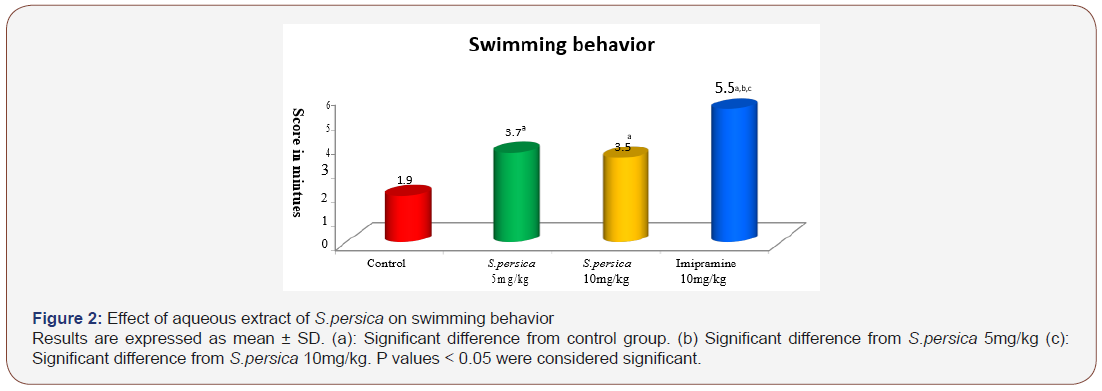Authored by Tahani H Ibrahim*,
Abstract
Background: Worldwide herbal therapies was considered as alternative of traditional medicines in treatment of many condition including neurological disorders, especially in treatment of depression which recently affecting large group of the general population. Salvadora persica (S. persica), which has different names including Miswak, Siwak, or Arak, has been used traditionally for many purposes among muslim society. Phytochemical screening of S. persica revealed the presence of saponins, flavonoids, steroids, phenols and tannins, which are valuable as antimicrobial, antiallergic, antioxidant, antiradical and anti-inflammatory.
Objective:
The present study aimed to evaluate the antidepressant activity of S. persica aqueous extract in albino mice using forced swimming test.Materials and methods:
The antidepressant effect of the aqueous extract was evaluated using forced swimming test, the evaluation was done by recording immobility and swimming time for 6 minutes test. Mice were divided into four groups (6 mice in each group). Group I, control group, was given normal saline10ml/kg. Group II and III received 5mg/kg and 10mg/kg of S.persica extract respectively. Group IV, reference group, was given imipramine 10 mg/kg. All the doses were given intraperitoneallyResults:
The aqueous extract of S. persica (5mg/kg and 10mg/kg) and imipramine produced significant decrease (P<0.05) in the duration of immobility compared to the control group. On the other hand, S. persica extract exhibit significant (P<0.05) increase in swimming time when compared to control group. Imipramine produced significant increase in swimming time when compared to both S. persica extract and control group.Conclusion:
We concluded that the aqueous extract of S. persica have significant antidepressant activity. However, further studies are needed to isolate the active constituents, and to find the exact mechanism of action.Keywords: Salvadora persica; Miswak; Depression; Force swimming test; Imipramine
Introduction
Depression is a public and common health problem, affecting large group of the general population and responsible for spending multibillion-dollar expenditures related to health care and hospitalizations directly and related to the rate of morbidity and mortality indirectly [1,2]. It can cause significant decreases in patient welfare and social performance and leads to great pain and suffering for the affected individuals, their family and friends [1-3]. This disorder is related to the effect of monoamines in the brain, especially to 5-hydroxytryptamine (5-HT) and noradrenaline [4]. The disease was characterized by apathy, loss of energy, retardation of thinking and activity, as well as thorough feelings of bleakness, isolation, despair and suicidal ideation,[5] approximately between 10 and 20 million suicide attempts annually [6]. It has many different causes which may related to environment or mode of life surrounding affected patient, modernization of habits, worries, and stressing professional situations which directly related to the patient [7].
According to the World Health Organization “psychological and physical health are crucial to the well-being of individuals. Nevertheless, only a small number of populations suffering from this disorder receive treatment” [8]. The factor which increased this problem and make the illness more critical and severe is inability to access affordable treatment [4]. Because of that, and in addition to adverse side effects including sedation, sleep disturbance, and sexual dysfunction which usually notice with all pharmacological treatments available to be use in this disorder there is a great interest to discover new agents acting on central nervous system [9,10]. Worldwide herbal therapies were considered as alternative or complementary to traditional pharmacological medicines for the treatment of many condition including neurological disorders, and research has continued to progress and expanded to searching of new molecules and agents can be used in these disorders [11].
Salvadora persica (S.persica ) which belong to family Salvadoraceae is used for many medical and nonmedical purpose among population specially in muslim society. It has different names in different regions and countries including Miswak, Siwak, or Arak in the Middle East; Miswak in Tanzania; Datan and Miswak in India and Pakistan [12]. Chemical analysis of Salvadora persica discover the presence of many ingredients including chlorides, salvadourea, organic compound, alkaloids, fluorides, silica, sulfur, tannins, saponins, flavonoids, sterols, sodium chloride and potassium chloride [13,14]. The various constituents of Salvadora persica have many beneficial biological properties, including antibacterial and antifungal activity [15]. The present study aimed to evaluate the antidepressant activity of Salvadora persica aqueous extract in albino mice using forced swimming test, which is the common animal model used to study depression because its representation a depressive-like behavior [16]. The hypothalamic pituitary adrenal axis and/or the sympatho-adrenomedullary system is the suggested mechanism responsible for this effect [17].
Materials and Methods
Collection of plant material
The plant was be collected from the researcher garden by researcher. Identification was authenticated by an herbarium from Qassim University.
Preparation of aqueous extract
The root sticks were cut into small pieces then made into a powder form. Ten grams taken from the powder will be heated in 50ml distilled water at 80°c for 10 minutes, then filter the mixture and the resulting decoction prepared daily just before work starting.
Experimental models
Swiss albino mice of either sex weighing approximately 20-25g was obtained from the animal house of Qassim University. They were housed with free access to pellet diet and tap water in cages under standard environmental conditions. The use of animals and experimental protocol had the prior approval of the Experimental Animal Care and Use Committee of the Department of Pharmacology, College of Pharmacy, Qassim/Saudi Arabia
Antidepressant activity
Experimental design for anti-depressant activity: The mice were divided into four groups (n=6). Drugs/ vehicle were administered to the animals 60min prior to study.
A. Group I: control group received normal saline 10 ml/kg intraperitoneal (IP).
B. Group II: were given S.persica 5mg/kg IP.
C. Group III: were given S.persica 10mg/kg IP.
D. Group IV: reference group received the standard drug imipramine 10mg/kg IP.
Forced swim test
For the forced swim test (FST), mice of either sex were individually forced to swim in an open cylindrical container (diameter 15cm, height 25cm) containing 15cm of water at 25±1°c. Treatment was given 60min prior to study as described by study design. All animals forced to swim for 6min, and the duration of immobility was observed and measured during the final 4min interval of the test. Each mouse judged to be immobile when it ceased struggling and remained floating motionless in the water, making only those movements to keep its head above water. A decrease in the duration of immobility is indicative of an antidepressant like effect [18].
Statistical analysis
The results presented as mean ± SD and the comparisons between the experimental groups performed using ANOVA test on SPSS version (21). A ‘p’ value < 0.05 was considered significant.
Result
Effect of S.persica extract on immobility behavior
S.persica at dose 5mg/kg and 10mg/kg produced significant (P<0.05) decrease in duration of immobility (1.9±0.49) and (2.21±0.23) respectively, in comparison with the control group (3.99±0.73). While the standard antidepressant drug, Imipramine at dose 10 mg/kg produced a significant decrease in immobility time (1.24±0.000) in comparison with the control group and S.persica extract(10mg/kg) as shown in (Table1) (Figure 1).
Table 1: Effect of S.persica on Immobility Behavior.


Effect of S.persica extract on swimming behavior
The effects of extract on duration of swimming behavior have been shown in (Table 2) (Figure 2). S.persica at dose 5mg/kg and 10mg/kg exhibited a significant (P<0.05) decrease in duration of immobility (3.7±0.61) and (3.5±0.35) respectively, in comparison with the control group (1.9±0.23). Similarly, animals treated with standard antidepressant drug, Imipramine at dose 10 mg/ kg showed a significant decrease in immobility time (5.5±0.27) in comparison with all the groups.

Table 2: Effect of S.persica on swimming Behavior.

Discussion
Forced swimming test is the most widely known model for antidepressant screening [18]. It is relatively simplistic and widely used model of depression originally adopted by Porsolt, et al. (1978) [15]. In the test, mice were forced to swim in confined environment from which they cannot escape. This leads to induction of behavioral despair in animals, which mimic the symptoms of depression in humans [19]. On the other hand, swimming behavior reported fight to life [20]. The results from the present study revealed that intraperitoneal administration of aqueous extract of S.persica (5mg/kg and 10mg/kg), and imipramine (10mg/kg) produced significant decrease in the duration of immobility ((1.9±0.49, 2.21±0.23, and 1.24± 0.000, P < 0.05)) respectively when compared with control group (3.99±0.73). In addition to that imipramine showed significant decrease in immobility time when compared to S.persica extract (10mg/kg). These results were in consistent with pervious study done by Ramadan, et al. [15].
Regarding swimming behavior, S.persica extract exhibit significant (P<0.05) increase in swimming time when compared to that observed in the control group. The standard drug, imipramine produced significant (P< 0.05) increase in swimming time when compared to both S.persica extract and control group. The above results were interesting as the monoamine hypothesis, proposes that decreasing the levels of one or more brain monoamine neurotransmitters, such as 5-hydroxytryptamine (serotonin), norepinephrine or dopamine, can be responsible of depressive symptoms [21]. The effect of imipramine in the test is due to augmented availability of norepinephrine and serotonin following reuptake inhibition [22]. In previous studies, phytochemical screening of S.persica revealed the presence of phenols, glycosides and flavonoids, [23] which converted to conjugated metabolites, [24] and transported via the blood brain barrier into the brain tissues, [25,26] hence it was proposed that these metabolites protect the brain from disturbance [20].
In summary, this study verified that acute administration of the S.persica produced antidepressant like effect on mice which reflected by decreasing depressive like behavior . This is like pervious study conducted on the same plant, except that in our study we used different route of administration (IP rather than oral), and the S.persica extract was acutely given once.
Conclusion
We concluded that the aqueous extract of S.persica have significant antidepressant activity. However, further studies are needed to isolate the active constituents responsible for this activity, and to find the exact mechanism of action of the plant extract to develop new target and molecules for treatment of depression.
To read more about this article...Open access Journal of Pharmacy & Pharmacology Research
Please follow the URL to access more information about this article
To know more about our Journals...Iris Publishers





No comments:
Post a Comment